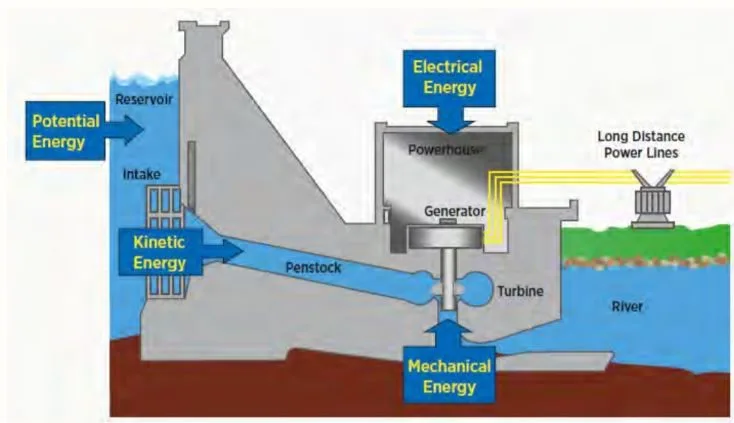Syllabus: GS3/Infrastructure
Context
- The Union Cabinet has approved the proposal of the Ministry of Power for modification of the scheme of budgetary support for the cost of Enabling Infrastructure for Hydro Electric Projects (HEP).
About
- The scheme would be implemented from FY 2024-25 to FY 2031-32.
- The Government of India has been taking several policy initiatives to address the issues impeding Hydro Power development, viz., remote locations, hilly areas, lack of infrastructure etc.
- The scheme will be applicable to all Hydro Power Projects of more than 25 MW capacity including the private sector projects which have been allotted on a transparent basis.
- This scheme will also be applicable to all Pumped Storage Projects (PSPs).
- Benefits:
- This revised scheme would help in faster development of hydro electric projects, improve infrastructure in the remote and hilly project locations and would provide a large number of direct employment to the local people.
- It would encourage fresh investments into the hydro power sector and incentivize timely completion of new projects.
What is Hydropower?
- Hydropower, or hydroelectric power, is one of the oldest and largest sources of renewable energy, which uses the natural flow of moving water to generate electricity.

- Hydropower currently generates more electricity than all other renewable technologies combined and is expected to remain the world’s largest source of renewable electricity generation into the 2030s.
- Classification of Hydro Projects based on Installed Capacity:
- Micro: Upto 100 KW
- Mini: 101KW to 2 MW
- Small: 2 MW to 25 MW
- Mega: Hydro projects with installed capacity >= 500 MW
- India: In 2022-23, hydropower accounted for 12.5 percent of power generation in India. India had about 4745.6 MW pumped storage capacity in operation in 2023.
- The hilly States of India mainly Arunachal Pradesh, Himachal Pradesh, Jammu & Kashmir and Uttarakhand constitute around half of this potential.
- Other potential States are Maharashtra, Chhattisgarh, Karnataka and Kerala.
| Do you Know? – Three Gorges Dam in China on Yangtze River is the largest hydro power station in the world. – In India, the oldest Hydropower power plant is in Darjeeling District in West Bengal. 1. Its installed capacity is 130KW and was commissioned in the year 1897. |
Significance of Hydro Power
- Renewable Energy Source: Hydropower is a renewable energy source because it relies on the water cycle, which is continuously replenished by rainfall and snowmelt.
- Clean Energy: Hydropower produces minimal greenhouse gas emissions compared to fossil fuels, making it an environmentally friendly option for generating electricity.
- Reliable and Predictable: Unlike solar and wind energy, which are intermittent and dependent on weather conditions, hydropower provides a consistent and reliable source of electricity.
- Flexible and Controllable: Hydropower plants can quickly adjust their output to match changes in electricity demand.
- Multipurpose Use: Hydropower projects often serve multiple purposes beyond electricity generation.
- They can provide flood control by regulating water flow, irrigation for agriculture, water supply for communities, and recreational opportunities such as boating and fishing.
- Long Lifespan: Hydropower infrastructure, such as dams and turbines, can have long lifespans, often exceeding 50 years with proper maintenance. This longevity ensures a stable and enduring source of energy for a longer period of time.
Challenges
- Environmental Impact: Large-scale hydropower projects often require damming rivers, which alter ecosystems, disrupt fish habitats, and impact local biodiversity.
- It also leads to issues like sediment buildup and water temperature changes downstream, affecting aquatic life.
- Social Impacts: Building dams and reservoirs displace communities and disrupt livelihoods, especially those relying on the affected rivers for fishing or agriculture.
- High Initial Costs: Constructing hydropower facilities involves significant upfront investment costs.
- Climate Change Vulnerability: Hydropower generation relies on consistent water flow, which can be affected by climate change-induced variations in precipitation patterns and glacial melt.
- A UK based thinktank found that the drought — likely exacerbated by climate change — drove an 8.5% drop in hydroelectricity around the world over the last two decades.
- Sedimentation: Dams trap sediment flowing downstream, leading to reservoirs gradually filling up with sediment over time.
- This reduces the reservoir’s capacity and impacts the efficiency and lifespan of the hydropower facility.
- Maintenance Challenges: Hydropower infrastructure requires regular maintenance to ensure safe and efficient operation.
Way Ahead
- The solution for the countries is to diversify their power sources by incorporating other renewable technologies — such as wind and solar — into their energy mix.
- Innovations around placing floating solar panels on the water’s surface in hydropower plants — as countries such China and Brazil are exploring — have significant potential.
- Building more medium scale plants, rather than the mega dams of the past, would help mitigate the climate-risks associated with overdependence on one big piece of infrastructure.
- Without major policy changes, global hydropower expansion is expected to slow down this decade.
Source: PIB
Previous article
Delay in Appointment of NHRC Chairperson
Next article
Issue of Manpower Shortages in Indian Railways